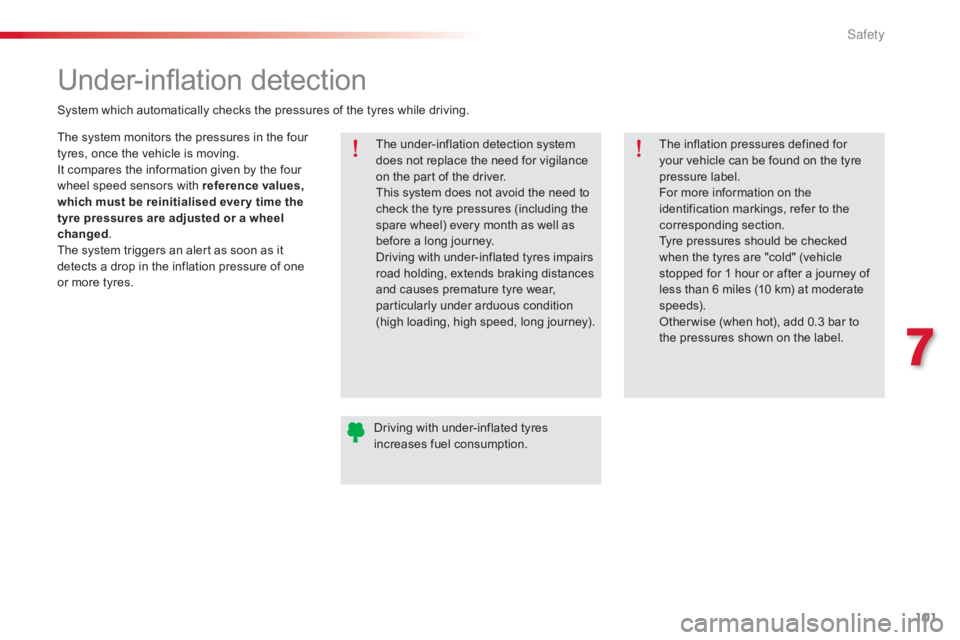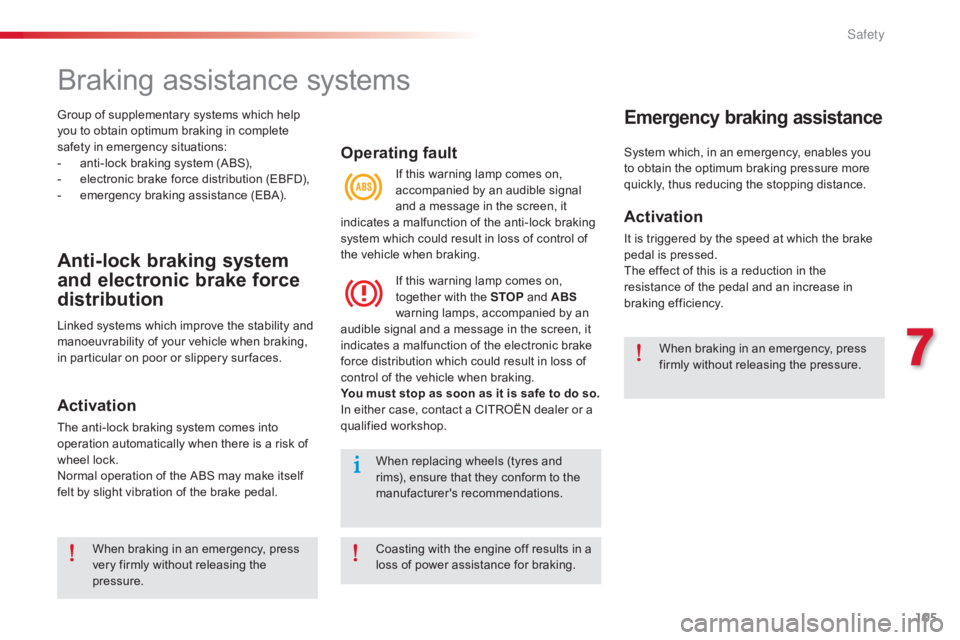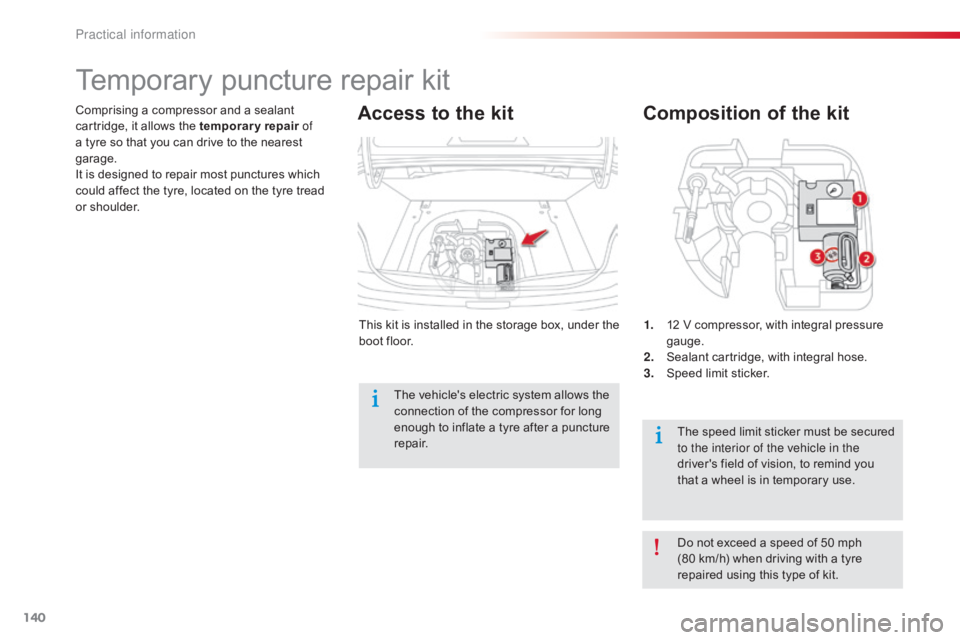2016 CITROEN C-ELYSÉE tyre pressure
[x] Cancel search: tyre pressurePage 6 of 260

4
10114 0 89
C-elysee_en_Chap00b_vue-ensemble_ed01-2016
Under-inflation detection
This system automatically checks the pressures of t
he tyres when driving and alerts you in the event of
u
nder-inflation.
Exterior
Temporary puncture
repair kit
This kit is a complete system consisting of a compressor and a sealant cartridge, to allow the temporary repair of a tyre.
Rear parking sensors
This system provides a warning when manoeuvring backwards by detecting obstacles located behind
t
he vehicle.
Over view
Page 11 of 260

9
Eco-driving
Limit the causes of excess consumption
Spread loads throughout the vehicle; place the heaviest items in the bottom of the boot, as close as possible to the rear seats.
Limit
the loads carried in the vehicle and reduce wind resistance (roof
b
ars, roof rack, bicycle carrier, trailer...). Use a roof box in preference.
Remove
roof bars and roof racks after use.
At
the end of winter, remove snow tyres and refit your summer tyres.
Observe the recommendations on maintenance
Check the tyre pressures regularly, when cold, referring to the label in the door aperture, driver's side.
Carry
out this check in particular:
-
b
efore a long journey,
-
a
t each change of season,
-
a
fter a long period out of use.
Don't
forget the spare wheel and the tyres on any trailer or caravan.
Have
your vehicle serviced regularly (engine oil, oil filter, air filter...) and
o
bserve the schedule of operations recommended by the manufacturer.
When
refuelling, do not continue after the 3
rd cut-off of the nozzle to a
void
any
over flow.
At
the
wheel
of
your
new
vehicle,
it
is
only
after the first 1 800 miles
(
3 000
kilometres)
that
you
will
see
the
fuel
consumption settle down to
a
consistent
average.
.
Page 19 of 260

17
C-elysee_en_Chap01_controle-de-marche_ed01-2016
C-elysee_en_Chap01_controle-de-marche_ed01-2016
Warning / indicator lampStateCause Action / Observations
Braking fixed. The
brake fluid level has dropped
s
ignificantly.You
must stop as soon as it is safe to do so.
Top
up with brake fluid listed by CITROËN.
If
the problem persists, have the system checked by a
C
ITROËN dealer or a qualified workshop.
+ fixed,
associated
w
ith the ABS warning
lam
p.The
e
lectronic
b
rake
f
orce
d
istribution
(
EBFD) system has a fault.You
must stop as soon as it is safe to do so.
Have
it checked by a CITROËN dealer or a qualified
w
orkshop.
Maximum
coolant
temperature fixed
red.The
temperature of the cooling
s
ystem is too high.Stop
as soon as it is safe to do so.
Wait
until the engine has cooled down before topping
u
p the level, if necessary.
If
the problem persists, contact a CITROËN dealer or
q
ualified
w
orkshop.
Under-inflation fixed,
accompanied by
a
n audible signal and
a
message.The
pressure in one or more tyres is
t
oo low.Check
the tyre pressures as soon as possible.
This
check should preferably be carried out when the
t
yres are cold.
You
must reinitialise the system after the adjustment
o
f one or more tyre pressures and after changing one
o
r more wheels.
For
more information on under-inflation detection,
r
efer to the corresponding section.
+ flashing
then fixed,
a
ccompanied by the
S
ervice warning lamp.The
system has fault: the tyre
p
ressures are no longer monitored.Check
the tyre pressures as soon as possible.
Have
the system checked by a CITROËN dealer or a
q
ualified
w
orkshop.
1
Monitoring
Page 103 of 260

101
C-elysee_en_Chap07_securite_ed01-2016
Under-inflation detection
The under-inflation detection system d
oes not replace the need for vigilance
o
n the part of the driver.
This
system does not avoid the need to
c
heck the tyre pressures (including the
s
pare wheel) every month as well as
b
efore a long journey.
Driving
with under-inflated tyres impairs
r
oad holding, extends braking distances
a
nd causes premature tyre wear,
p
articularly under arduous condition
(
high loading, high speed, long journey).The
inflation pressures defined for y
our vehicle can be found on the tyre
p
ressure label.
For
more information on the
i
dentification markings, refer to the
c
orresponding
s
ection.
Tyre
pressures should be checked
w
hen the tyres are "cold" (vehicle
s
topped for 1 hour or after a journey of
l
ess than 6 miles (10 km) at moderate
s
peeds).
Other wise
(when hot), add 0.3 bar to
t
he pressures shown on the label.
Driving
with under-inflated tyres
i
ncreases fuel consumption.
System
which
automatically
checks
the
pressures
of
the
tyres while driving.
The
system
monitors
the
pressures
in
the
four
t
yres,
once
the
vehicle
is
moving.
It
compares
the
information
given
by
the
four
w
heel
speed
sensors
with
reference values,
which must be reinitialised ever y time the
tyre pressures are adjusted or a wheel
changed .
The
system
triggers
an
alert
as
soon
as
it
d
etects
a
drop
in
the
inflation
pressure
of
one
o
r
more
tyres.
7
S
Page 104 of 260

102
C-elysee_en_Chap07_securite_ed01-2016
Before reinitialising the system, ensure that the pressures of the four tyres are
correct
for the use of the vehicle and in
l
ine with the recommendations on the
t
yre pressure label.
The
under-inflation alert can only be
r
elied on if the reinitialisation of the
s
ystem has done with the pressures in
t
he four tyres correctly adjusted.
The
under-inflation detection system
d
oes not give a warning if a pressure is
i
ncorrect at the time of reinitialisation.
The
loss
of
pressure
detected
does
not
a
lways
cause
visible
bulging
of
the
tyre.
D
o
not
satisfy
yourself
with
just
a
visual
c
heck. The
alert
is
maintained
until
the
system
i
s
r
einitialised.
Under-inflation alert
This is given by fixed illumination of t his warning lamp, accompanied by
a
n audible signal and the display of a
m
essage.
F
R
educe speed immediately, avoid
e
xcessive steering movements and sudden
b
raking
F
S
top the vehicle as soon as it is safe to
do so. F
I f you have a compressor (such as the one
i
n the temporary puncture repair kit), check
t
he pressures of the four tyres when cold.
I
f it is not possible to carry out this check
s
traight away, drive carefully at reduced
s
peed.
or
F
I
n the event of a puncture, use the
temporary
puncture repair kit or the spare
w
heel (depending on equipment),
Reinitialisation
It is necessary to reinitialise the system every time one or more tyre pressures are adjusted,
a
nd after changing one or more wheels.
Safety
Page 106 of 260

104
C-elysee_en_Chap07_securite_ed01-2016
Vehicles without display screen
F Open the glove box.
F M ake a long press on this button.
Reinitialisation
is confirmed by an low-pitched
a
udible
s
ignal.
A
high-pitched audible signal indicates that the
r
einitialisation has not been done.
The
new pressure settings registered are
c
onsidered to be reference values by the
s
ystem.
Operating fault
The under-inflation alert is only d ependable if the system has been
r
einitialised with all four tyres inflated to
t
he correct pressures.
Snow chains
The system does not have to be reinitialised after fitting or removing
sn
ow
c
hains. Before
doing anything to the system,
t
he pressures of the four tyres must be
c
hecked and the system reinitialised.
The
flashing and then fixed illumination of the
u
nder-inflation
w
arning
lam
p
a
ccompanied
b
y illumination of the Service warning lamp
i
ndicates a fault with the system.
In this case, under-inflation monitoring of the t
yres is no longer assured.
Have the system checked by a CITROËN
d
ealer or a qualified workshop.
S
Page 107 of 260

105
C-elysee_en_Chap07_securite_ed01-2016
Group of supplementary systems which help you to obtain optimum braking in complete
s
afety in emergency situations:
-
a
nti-lock braking system (ABS),
-
e
lectronic brake force distribution (EBFD),
-
e
mergency braking assistance (EBA).
Braking assistance systems
Anti-lock braking system
and electronic brake force
distribution
Linked systems which improve the stability and manoeuvrability of your vehicle when braking,
i
n particular on poor or slippery sur faces.
Activation
The anti-lock braking system comes into operation automatically when there is a risk of
w
heel lock.
Normal
operation of the ABS may make itself
f
elt by slight vibration of the brake pedal.
Operating fault
Emergency braking assistance
System which, in an emergency, enables you to obtain the optimum braking pressure more
q
uickly, thus reducing the stopping distance.
When
braking in an emergency, press
f
irmly without releasing the pressure.
When
braking
in
an
emergency,
press
v
ery
firmly
without
releasing
the
p
ressure. When
replacing
wheels
(tyres
and
r
ims),
ensure
that
they
conform
to
the
ma
nufacturer's
r
ecommendations.
If
this
warning
lamp
comes
on,
a
ccompanied
by
an
audible
signal
a
nd
a
message
in
the
screen,
it
i
ndicates
a
malfunction
of
the
anti-lock
braking
s
ystem
which
could
result
in
loss
of
control
of
t
he
vehicle
when
braking.
If
this
warning
lamp
comes
on,
t
ogether
with
the
STOP
and
ABS
warning
lamps,
accompanied
by
an
a
udible
signal
and
a
message
in
the
screen,
it
i
ndicates
a
malfunction
of
the
electronic
brake
f
orce
distribution
which
could
result
in
loss
of
c
ontrol
of
the
vehicle
when
braking.
You must stop as soon as it is safe to do so.
In
either
case,
contact
a
CITROËN
dealer
or
a
q
ualified
w
orkshop.
Activation
It is triggered by the speed at which the brake p edal is pressed.
The
effect of this is a reduction in the
r
esistance of the pedal and an increase in
b
raking
e
fficiency.
Coasting
with
the
engine
off
results
in
a
l
oss
of
power
assistance
for
braking.
7
Safety
Page 142 of 260

140
C-elysee_en_Chap09_info-pratiques_ed01-2016
1. 12 V compressor, with integral pressure ga
uge.
2.
S
ealant cartridge, with integral hose.
3.
S
peed limit sticker.
Composition of the kit
The speed limit sticker must be secured to the interior of the vehicle in the
driver's
field of vision, to remind you
t
hat a wheel is in temporary use.
This
k
it
i
s
i
nstalled
i
n
t
he
s
torage
b
ox,
u
nder
t
he
b
oot
floor.
Comprising
a
compressor
and
a
sealant
c
artridge,
it
allows
the
temporary repair
of
a
tyre
so
that
you
can
drive
to
the
nearest
g
arage.
It
is
designed
to
repair
most
punctures
which
c
ould
affect
the
tyre,
located
on
the
tyre
tread
o
r
shoulder.
Temporary pu
ncture r epair k it
Access to the kit
The vehicle's electric system allows the c
onnection of the compressor for long
e
nough to inflate a tyre after a puncture
r
epair.
Do
not exceed a speed of 50 mph
(
80 km/h) when driving with a tyre
r
epaired using this type of kit.
Practical information